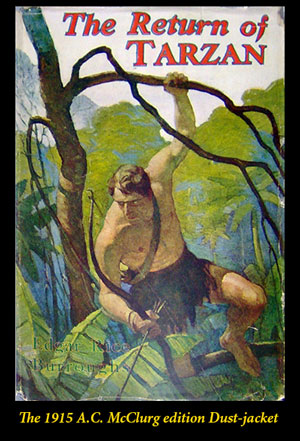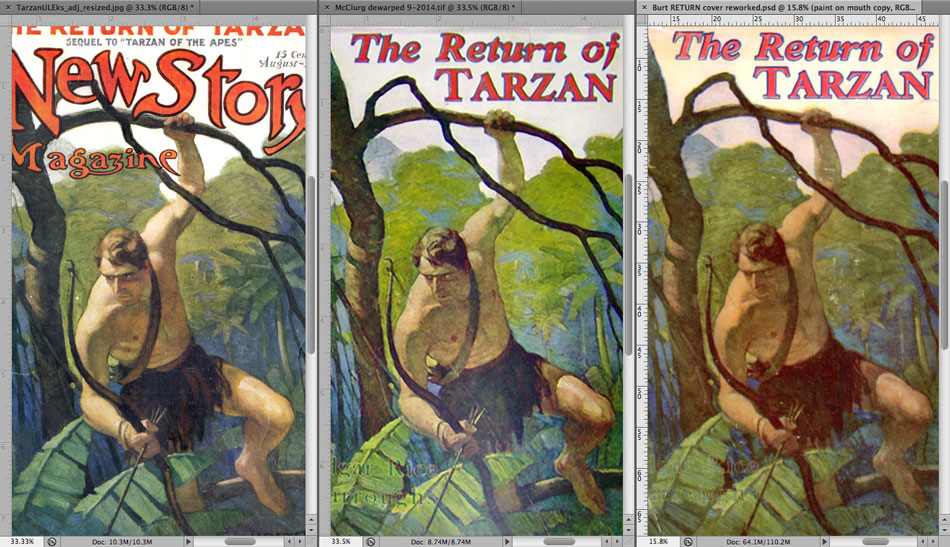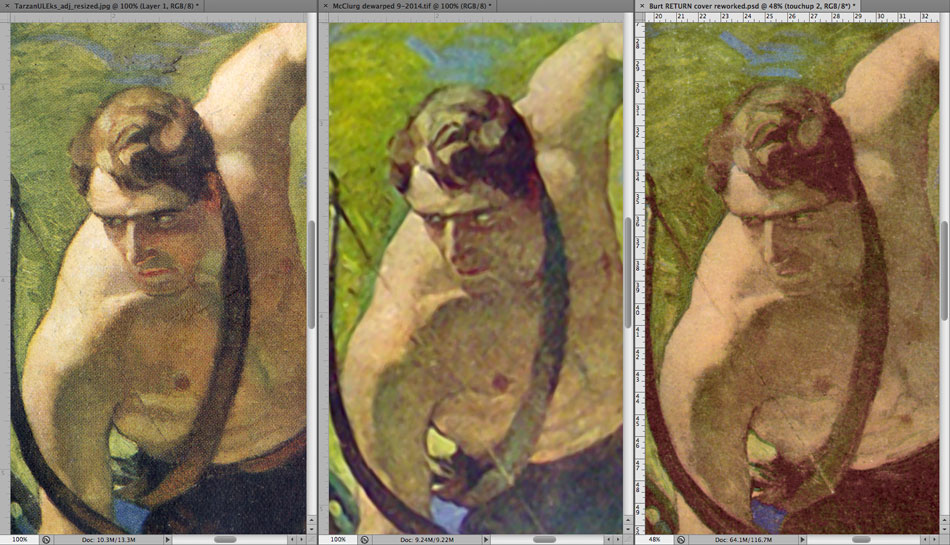THE WYETH / TARZAN REPORT — Part 2
©2014 Philip NormandThe Dust-jacket Printings of THE RETURN OF TARZAN

THE WYETH PAINTING was commissioned and printed on the New Story Magazine cover in New York, in August of 1913. Two years later, in March of 1915, the story appeared in hardcover from A.C. McClurg & Co. of Chicago.
A.C. McClurg used the W.F. Hall Printing Company for the production of the book. Hall had their own subsidiary typesetting and photoengraving department, Central Typesetting and Electrotyping Company, who we can assume not only typeset the book, but made the color separations for the dust-jacket as well. The painting for the cover had to be borrowed from Street & Smith, publisher of New Story Magazine, and shipped to Chicago, unless S & S supplied the separations through Colorplate Engraving in New York. In either case the art had to be re-photographed to fit the size of the book jacket which measured, on the front cover panel, approximately 5.125 x 7.625 inches, a 73% reduction of what had been produced for the pulp cover.
A new set of separations would mean a new process of engraving the plates and a new etcher working on them. A difference in cameras, materials, skills and other variables would ultimately produce an image slightly, though in some ways significantly, different from the image on New Story Magazine.
The book itself went through at least 6 printings with a total print run of 15,000 copies, an increase of 50% over the print run of Burroughs’ first book, TARZAN OF THE APES. One of the great mysteries of bibliography and book collecting is the scarcity of McClurg dust jackets for this book. With a print run of over 15,000 copies, considering the customary seconds, very few first edition dust-jackets for RETURN have ever turned up. At present only 3 are known to exist. What could have happened to the others? Dust-jackets for TARZAN OF THE APES, though rare, are not extremely difficult to find given a deep enough pocketbook. And there are several collections in existence which contain every other dust-jacket for a Burroughs book, in decent shape, other than that for RETURN. The difficulty of locating a first-edition dust-jacket, not to mention one in perfect register, makes it hard to examine exactly how well the reproduction reflects the original painting.
A. C. McClurg & Co. contracted with A. L. Burt Company in 1915 to sell “popular priced” reprints of the first five Tarzan titles. RETURN was reprinted by Burt in 1916. The reprints were possible because the same electrotyped page plates were used on Burt’s presses. The same electrotypes for the dust-jacket cover would also have been used with new promotional material added by Burt to the back cover and new copy for the flaps and spine. In 1927 Burt's reprint rights were released to Grosset & Dunlap who had been reprinting all the rest of the Burroughs catalog since 1918. The dust-jacket cover for the G&D reprints is exactly the same as the Burts except for more wear to the plates so I have not included an image of it here.
Though there are few images of the actual first edition dust-jacket for RETURN, a copy was offered for sale in February, 2014 and, though at a low resolution, photos of that copy do exist. Below is a comparison of the New Story cover, the McClurg first edition and the Burt reprint front covers. I have corrected the distortion in the existing McClurg jacket photo, which was taken at an angle, in order to approximate a flat direct shot of the jacket. Some color balancing and correcting was also done to both the McClurg and Burt to make them more clear and to remove the color-cast of the yellowed paper. Unfortunately a highlight from the photo flash in the McClurg jacket causes a whitish area in the lower center of that sample.

Most notable between the McClurg and the New Story covers is a certain “hardness” in the face and shading, a difference in the right torso underlighting and a lack of detail in the loincloth. Color differences between the covers should be discounted at this point because of the variations of printing.
Roll your mouse over the image to see the points of difference between the reproductions.
In this closeup of the Tarzan figure it is easier to distinguish the differences between the engraving made for New Story and that made for McClurg. the highlight on the quiver strap is more prominent on the McClurg, a small line continues the underside of the right shoulder on to the chest, darker demarcation lines suggest a stronger emphasis of the muscles that draw back the corners of the mouth (the zygomaticus and the buccinator). Due to loss of detail in the McClurg scan it is impossible to see the highlight on the left pupil but it does show up in the Burt sample even though the colors are out of register.
Certain other details of the painting are plainly visible including the strokes which make up the texture of Tarzan’s hair and the strokes in the background foliage around the top end of the bow. Another interesting “signature” is the break in the outline of the underside of the right arm where it passes in front of the arrows in the quiver. Roll your mouse over the image to see guidelines for these points.
Continue to part 3: The Painting Itself >
